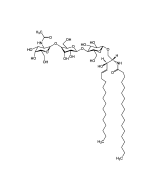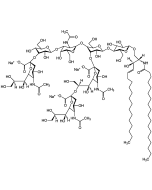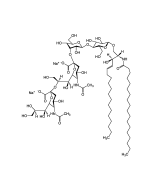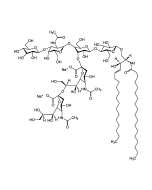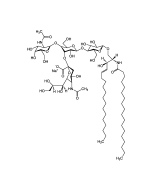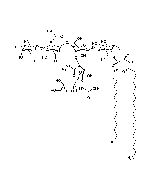Cookie Policy: This site uses cookies to improve your experience. You can find out more about our use of cookies in our Privacy Policy. By continuing to browse this site you agree to our use of cookies.
AdipoGen Life Sciences
Ganglioside GQ1b . tetrasodium salt (bovine brain)

| Product Details | |
|---|---|
| Synonyms | GQ1b . 4Na; Tetrasialoganglioside GQ1b . 4Na |
| Product Type | Chemical |
| Properties | |
| Formula |
C106H178N6O55 . 4Na |
| MW |
2416.6 . 92.0 (calculated on sphingosine C18:1 and stearic acid) |
| Sequence |
Structure: IV3Neu5Ac2II3NeuAc2GgOse4Cer; α-Neu5Ac-(2-8)-α-Neu5Ac-(2-3)-β-Gal-(1-3)-β-GalNAc-(1-4)-[α-Neu5Ac-(2-8)-α-Neu5Ac-(2-3)-]β-Gal-(1-4)-β-Glc-(1-1)-Cer; Cer: Sphingosine C18:1-C20:1, ~1:1 to 1:3 by vol.; stearic acid over 90% |
| CAS | 68652-37-9 |
| Source/Host Chemicals | Isolated from bovine brain. |
| Purity Chemicals | ≥98% (TLC) |
| Solubility | Soluble in water (micellar aggregates) or chloroform:methanol (2:1). |
| Formulation | Lyophilized. |
| Endotoxin Content | Not detectable. |
| Identity | Determined by 1H-NMR, MS and HPTLC. |
| InChi Key | QISNAVHLOKDTLS-UTKQHEHRSA-J |
| Smiles | [Na+].[Na+].[Na+].[Na+].[H][C@@](O)(CO)[C@]([H])(O)C1O[C@@](CC(O)[C@H]1NC(C)=O)(O[C@@]([H])(CO)[C@]([H])(O)C1O[C@@](CC(O)[C@H]1NC(C)=O)(O[C@H]1[C@H](O)C(CO)O[C@@H](OC2[C@@H](O)[C@H](CO)O[C@H](O[C@H]3C(CO)O[C@@H](O[C@H]4C(O)C(O)[C@H](OC[C@]([H])(NC(=O)CCCCCCCCCCCCCCCCC)[C@]([H])(O)\C=C\CCCCCCCCCCCCC)O[C@H]4CO)C(O)[C@H]3O[C@@]3(CC(O)[C@@H](NC(C)=O)C(O3)[C@@]([H])(O)[C@]([H])(CO)O[C@@]3(CC(O)[C@@H](NC(C)=O)C(O3)[C@@]([H])(O)[C@]([H])(O)CO)C([O-])=O)C([O-])=O)C2NC(C)=O)C1O)C([O-])=O)C([O-])=O |
| Shipping and Handling | |
| Shipping | AMBIENT |
| Short Term Storage | +4°C |
| Long Term Storage | -20°C |
| Handling Advice |
Hygroscopic. Protect from moisture. |
| Use/Stability | Stable for at least 2 years after receipt when stored at -20°C. |
| Documents | |
| MSDS |
 Download PDF Download PDF |
| Product Specification Sheet | |
| Datasheet |
 Download PDF Download PDF |
Gangliosides are acidic glycosphingolipids that form lipid rafts in the outer leaflet of the cell plasma membrane, especially in neuronal cells in the central nervous system. They participate in cellular proliferation, differentiation, adhesion, signal transduction, cell-to-cell interactions, tumorigenesis and metastasis. The accumulation of gangliosides has been linked to several diseases. Ganglioside GQ1b specifically promotes neural differentiation of human neuroblastoma cells. Anti-GQ1b antibodies are present in serum from Miller-Fisher syndrome patients.
- Role of membrane gangliosides in the binding and action of bacterial toxins: P.H. Fishman; J. Membr. Biol. 69, 85 (1982)
- A novel glycosignaling system: GQ1b-dependent neuritogenesis of human neuroblastoma cell line, GOTO, is closely associated with GQ1b-dependent ecto-type protein phosphorylation. S. Tsuji, et al.; Neurochem. 21, 549 (1992)
- Dynamic and structural properties of sphingolipids as driving force to the formation of membrane domains: S. Sonnino, et al.; Chem. Rev. 106, 2111 (2006)
- Fisher syndrome: clinical features, immunopathogenesis and management. M. Mori, et al.; Expert Rev. Neurother. 12, 39 (2012)
- Homeostatic and pathogenic roles of GM3 ganglioside molecular species in TLR4 signaling in obesity: H. Kanoh, et al.; EMBO J. 39, e101732 (2020)






